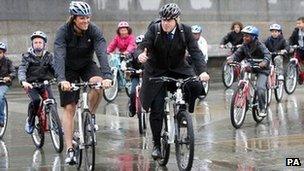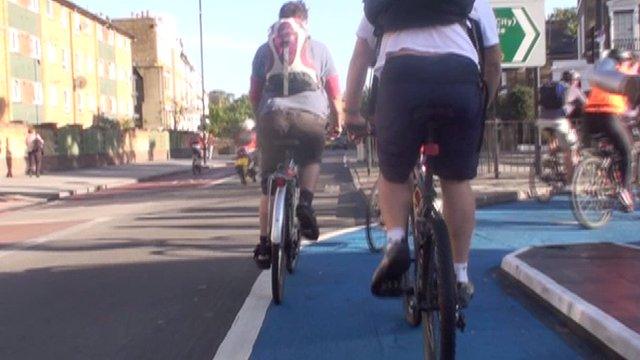Will 'bold' cycle safety report stop deaths?
- Published
- comments
Dr Tom Konig has questioned whether the Mayor's Cycling Superhighways are safe particularly at night
Cycling still has the ability to create headlines and headaches for those running London.
This week saw a report published by the London Assembly and you can see my film report on it here.
On Wednesday we interviewed Dr Tom Konig, a cyclist and doctor with the London Air Ambulance. He regularly sees cyclists who have received life-changing injuries from collisions.
His solution is more segregation, particularly at junctions.
Dr Konig has attended 58 serious cycling incidents so far this year and is extremely frustrated at the lack of action being taken to protect cyclists.
"A number of those 58 this year have died and we are already matching last year's figure and we've still got five or six weeks left of the year," said Dr Konig.
"So, we're not winning that game and sadly those that are losing it, are losing their lives. There is still work to be done."
He is questioning the safety of cycling superhighways, particularly at night, and says cyclists need to be segregated and given respect by motorists.
British Cycling called London Assembly's report 'bold' and what made this report different was it seemed apolitical and it also made firm recommendations:
The mayor should establish a far more ambitious target for cycling, bringing forward his target of a five per cent increase in cyclists from 2026 to 2020;
The mayor and Transport for London's (TfL) new business plan, due to be published in December, should commit to doubling the amount of funding for cycling;
The mayor and TfL should commit to introducing fundamental cycle safety improvements to junctions, based on high quality Dutch/Danish planning and design principles;
The mayor and TfL should reassess the space allocated to cycling in the design of cycle route and junction infrastructure;
Where there is existing provision for the mayor and TfL to use innovative road design and technological solutions to improve cycle safety, they should do so;
The mayor and TfL need to revise the Road Safety Action Plan to reflect the forthcoming independent review of construction HGV vehicle design;
TfL should report back to the committee on the steps it is taking with the Metropolitan Police on cycling safety, including increase enforcement of 20mph limits and improved driver awareness.

London Assembly's transport committee recommends doubling TfL's funding for cycling
Broadly what it means is more money to improve junctions and more road space to be given over to cyclists which will be extremely contentious.
The assembly is, to some extent, pushing at an open door with some of these proposals, so the question is when will definitive changes be made?
There will be a lot of interest in the mayor's cycling strategy. We would expect more investment and segregation at key junctions.
It sounds like there is some wrangling over the amount of funding that will be available for cycling and presumably other projects will have to be cut back or delayed.
There are also questions over how London will look in the future. Will there be fewer car-free areas in 50 years' time? Will we see more pedestrianised areas?
Also, it'll be interesting to see how the cycling strategy is received as cycling campaigners now feel empowered and are well organised.
Bear in mind, reaction to changes at Blackfriars Bridge and the controversial Bow roundabout has not been favourable.
- Published21 November 2012
